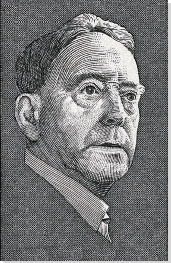Summary of John Heartfield
Only recently has John Heartfield's work been studied on its own terms, as progressive graphic design. Heartfield's formative training in advertising and experiences with Dada theatricality provided him with the visual tools to affect and persuade viewers to action and critical thinking. Heartfield's pro-communist, anti-capitalist photomontages emerge in a moment of war and revolution, and in dialogue with the late Weimar Republic's commodity culture. His provocative photomontages aroused both critical acclaim as well as controversy at the time - especially famous are his anti-fascist montages, for which he was persecuted by the Nazis and spied on by Gestapo agents. The capacity of Heartfield's photomontages to provide a technique through which to conceive alternative views of reality is his contribution to artistic practice across the media arts.
Accomplishments
- Heartfield caused the times to speak for themselves through cut-out fragments from everyday materials, such as advertisements, newspapers, and illustrations. He provoked reality to snap its own picture through excerpts taken from popular mass media products, as a variation on a cameraless photographic process.
- Heartfield's name is synonymous with his 1930s antifascist photomontages. He became known for his one-man battle against Hitler due to his concentrated critique of this dictator as a liar, backed by the big industrialists.
- Montage, for Heartfield, was a vernacular art form, readily used for propaganda and commercial purposes. The Berlin Dadaists used photomontage to rupture the commercialized media's view of reality by dismantling it into fragmented parts. Cubism dismantled the mimetic representation in art. Similarly, Heartfield's violently cut and pasted fragments with their rough edges exposed the media's realistic description of the world as a mimetic illusion. To call the authenticity of reality into question was to show the masses how they had traded in their own perception of reality for the media's view. Regrettably, these Dadaists lacked a popular audience.
- Heartfield's agitational method, equated with the worker photography movement's notion of "photo as weapon," aimed to visualize the realities that lay behind the agitation for war or whatever cause the government persuaded the citizens to back. Heartfield's seamlessly sutured photomontages show how the photographic medium was mere artifice. The montaged interplay of animal and human, animate and inanimate, technological and "natural" are revealed as the hidden structure in mechanical reproductions under industrial capitalism.
Important Art by John Heartfield
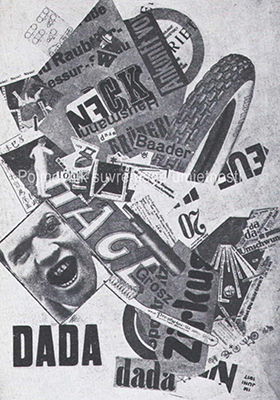
Cover for Der Dada, "The Tire Travels the World"
This photomontage suggests the dynamic movement of the Republic automotive tire that runs over, crashes against, moves around emphatic slogans, ads, world news, and various Dada nonsense. The cut-out words and images drawn from newspapers, advertisements, and magazines are used to spell non-words, such as "DADA," and project the Dadaist outrage at the status quo (its rational norms and values), as seen in the shouting face of the dandy Raoul Hausmann in the bottom left corner of the montage. This Dada montage intended to playfully jolt the viewer to confront the contemporary moment of social and political crisis.
Photomontage enabled the Dadaist Heartfield to allow the news headlines and advertising slogans to speak for themselves in the form of fragmented words and images that conveyed the social turmoil and the cacophony of the urban street of commerce and news. Hannah Höch, like Heartfield, appropriated mass media fragments. Yet, Höch created a cohesive image out of these pieces to critique the patriarchal political establishment. The very use of commodities (e.g. the tire), advertisements, and the very language of photographic mass media demonstrates how the Dadaists mocked and even broke down the conventional means of representation ubiquitous in the visual culture of the Weimar Republic.
Newsprint - The Art Institute of Chicago
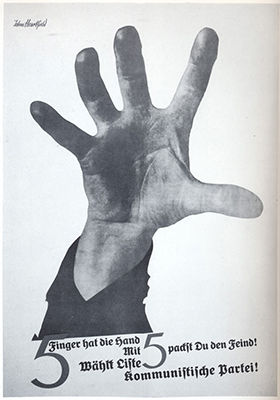
The Hand Has Five Fingers
An oversized grasping hand energetically confronts the viewer. This popular 1928 election poster equates the five fingers of the laboring hand with the number 5 of the Communist Party's electoral list. On the morning of May 13, 1928, commuters, pedestrians, and all city dwellers would have seen this affective poster plastered throughout the urban areas of Berlin, and even on the front page of the Red Flag (Die Rote Fahne), Sunday issue, as readers opened the folded paper to its length. This image unequivocally urged them to vote the party's electoral list. It demonstrates how Heartfield used advertising techniques for the purpose of political persuasion to great effect. This symbol of the working hand was one among the many political symbols Heartfield produced that resonated with the working classes.
Under the tutelage of Ernst Neumann, a renowned professor of advertising design, Heartfield learned how to attract the attention of potential customers by means of an optical surprise, achieved by pairing two often-oversized figures or objects with an emphasis on simplicity. Here Heartfield pairs the number five with the hand's five fingers. This optical surprise was most effectively delivered in what was called an "object poster" that highlighted a company's trademark or commodity devoid of any decorative flourishes. For this poster, Heartfield deployed this concept to great effect in synthesizing the demands of the workers with the Communist Party's electoral platform.
Gravure - Akademie der Künste, Berlin
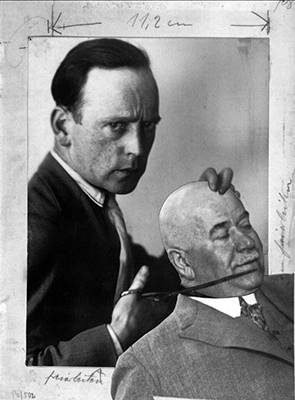
Self-Portrait with the Police Commissioner Zörgiebel
This self-portrait captures Heartfield in the act of "cutting off" with scissors the police commissioner Zörgiebel's head in a printed photograph. It is a literal description of his technique of gathering needed printed and visual material to construct his montaged-images. This is also a mock execution, a satirical critique of this police commissioner's ruthless policies - for example, the unprecedented police violence unleashed against the Communist demonstrators on May Day, 1929 in Berlin. Here in this mock-up of the montage, it is evident how the abutting images of Heartfield with scissors and the head of Zörgiebel are simultaneously hinged together and severed by the scissors. Heartfield intentionally aimed to show his technique and perform his social identity as an artist, as he conceived it in 1929. He designed this violent image for the well-established mass-circulating leftist AIZ. The image insists on being understood in pictorial terms due to the absence of any text. This self-portrait provides an opportunity to see his self-constructed visual utterance about himself and his artistic project to counter social injustice.
This montage-image introduced the readers of the AIZ to the political photomonteur John Heartfield in the magazine's September 1929 issue, as an endorsement for his collaboration with Kurt Tucholsky on the soon to be published book Germany, Germany above All. This endorsement was a practical strategy on the part of the New German Publishing Company (Neuer Deutscher Verlag), the publisher of both the AIZ and the satirical book. This montaged self-portrait of Heartfield showcases his critical art, which boldly fused Dada theatricality with a resolute political stance. Such declarative self-representations were rare, as Heartfield soon became embroiled in internal Communist party politics. His brother Wieland Herzfelde, as the art historian Sabine Kriebel noted, actively participated in the narrative construction and replication of Heartfield's life, but it became more necessary in the thirties for him to adjust facts, simplify the narrative, and emphasize certain details to promote an exemplary account of their lives so they could survive the shifting political climate of the time. For instance, Wieland thought it best for his brother to deny, as of 1936, to have ever worked for Münzenberg, who became a non-person and a renegade in the eyes of the Communist International (Comintern) in 1936.
Mock-up - Akademie der Künste, Berlin
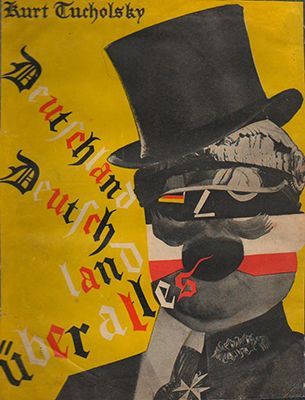
Cover and illustrations for Kurt Tucholsky, Germany, Germany above All
Heartfield personifies Germany in the cover image of the book Germany, Germany above All, as a composite figure: judicial and military costumes define his body, his face is statesman, nationalist, military, and bourgeois combined - as indicated by the loose joule below the chin and mustache, the red and white colors of the German Socialist Democratic Party, the military hat, and bourgeois top hat. Additionally, the words "Deutschland, Deutschland über alles," written in fraktur script, spill out of the figure's mouth, suggesting he is merrily singing the national anthem. The back cover reinforces the alliance between social and military order by juxtaposing the police's baton and the military sword. This montaged-cover together with the montaged images inside this picture book aptly characterizes how Heartfield's work was deeply immersed in a dialogue with the cultural crisis of the late Weimar Republic.
Kurt Tucholsky authored the book Germany, Germany above All, and Heartfield designed its cover in 1929. This picture book trenchantly criticized right-wing nationalism, the military, the democratic system, and capitalism. The book is considered to be just as much about the role of photography in society as it is about the political situation in the Weimar Republic. It deftly captures the so-called optimism of Weimar visual culture as well as its abrupt interruption by fascism in the 1930s. Tucholsky's and even Heartfield's ambivalence towards photography mirrors the dilemma of the times: the critique and frustration with photojournalism and its association with urban modernity, and at the same time, the critical tool it had become in the hands of such artists as John Heartfield.
Letterpress inset on canvas - The Art Institute of Chicago, Chicago
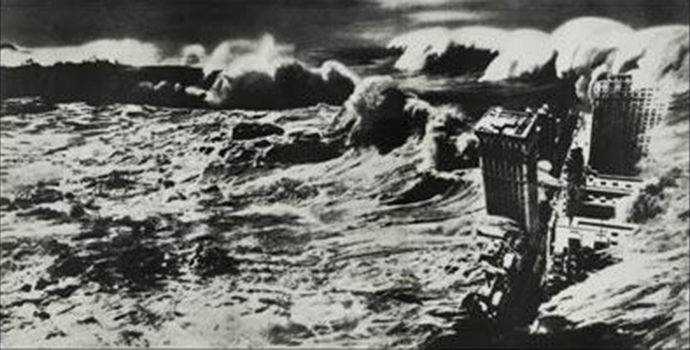
Book jacket design for Upton Sinclair's book After the Flood
Heartfield's book jacket design for Upton Sinclair's book After the Great Flood: A Novel from the year 2000 (1925) visualizes a great wave swallowing a city. Heartfield effectively uses a montaged image of a tsunami-size wave and a skyscraper in the form of a single photograph across the front and back covers. It is simply framed at the top and bottom by a band of red, on which the author's name, the book's title, and Malik Verlag logo are printed. This singular image not only powerfully conveyed Sinclair's core message: the inevitable destruction of humankind by its own scientific experiments, but also Heartfield's clever use of a single image.
Upton Sinclair unwittingly shared the progressive avant-garde's sensing of an impending disaster, here expressed in prophetic terms of a biblical deluge. The critique of rationality during the Weimar Republic expressed dissatisfaction with science and concern about the psychological and social consequences of the mechanized and standardized experience of the individual. Such images of a doomed social and economic order with the specter of utter political disintegration seemed commonplace at the time. More pointedly, Heartfield's montage juxtaposes fantasy and reality, illusion and disillusionment to engage the viewer visually and sensorily.
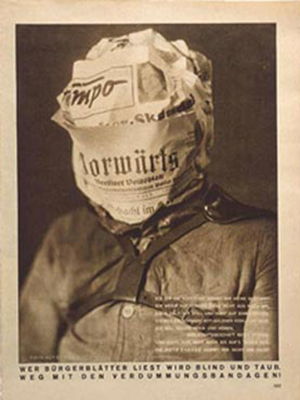
Whoever reads bourgeois newspapers becomes blind and deaf: away with the stultifying bandages! Arbeiter-Illustrierte Zeitung (AIZ) 9. no. 6
By wrapping this young man's head in the pages of the German Social Democratic Party's newspaper Onward (Vorwärts), this photomontage suggests that he has become blinded and even deaf to the reality that surrounds him. The caption reads: "I am a cabbage head. Do you know my leaves (which means both newspapers and cabbage leaves in German)? Whoever reads bourgeois newspapers becomes blind and deaf." Visually the body sits in undisturbed repose, expressing the person's frightful complacency with what he reads. This is suggested by allowing the text across his head to speak for him. As the art historian Sabine Kriebel noted, Heartfield plays on features of earlier studio photographs, such as the aureole that surrounds the body contours, while surface details stand out in sharp relief, to suggest long exposure (associated with such studio photographs) and the instantaneity of photojournalism (its snapshots of world events).
Heartfield's montage aims to critique commercial photomontage; its easy manufacture and reproduction. It confronts the ethos of speed and excess in the market of mass-illustrated magazines and the continuous barrage of visual stimuli that had the effect of numbing the readers' senses. By comparison, the qualities of Heartfield's photomontages assert a diligent, revolutionary staying power that defined his scrupulously crafted montages, which secured the viewer's attention through their perceptual and psychological, yet humorous affective devices.
Offset print - Getty Research Institute, Los Angeles
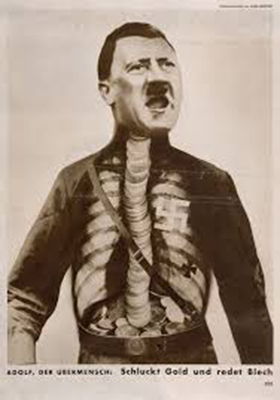
Adolf the Übermensch: Swallows gold and spouts junk, AIZ 11. no. 29, July 17
This photomontage reveals Adolf Hitler, the leader of the National Socialists, as orator, who speaks mere rhetoric or rather junk. Heartfield playfully integrates an authentic likeness of Hitler with an x-ray image of a torso, which exposes the ribs and esophagus, to show how Adolf, a gluttonous swallower of big industry's money, spouts meaningless words. Monetary exchange is made physically real and at once repulsive as it is presented in the abstract form of a digestive body, which symbolizes a system of ingestion and suggested regurgitation. Heartfield's montage, published in the AIZ, preceded an article that examined the distinction between the anticapitalist rhetoric of the Nazis and their pro-capitalistic practices. It showcases Heartfield's play with fantasy and reality to provoke critical thinking.
The precedent for this photomontage is French artist Honoré Daumier's scandalous Gargantua, a political cartoon, inspired by Rabelais's gluttonous tale about the giant Gargantua and his son Pantagruel, which places the bulbous body of French King Louis-Philippe I at the center of monetary digestion. Exhausted, gaunt workers and tired mothers gather at the bottom of a plank to drop their coins into baskets, which the king's ministers carry up to the his pear-shaped head and deposit them into his gaping mouth with assembly-line efficiency. Heartfield's montage like Daumier's, according to the art historian Sabine Kriebel, is an allegory for the consumption and production of capital, power, and subjugation. Heartfield inherits Daumier's legacy and continues this leftist tradition of mass media caricature, which is evident in this montage about Hitler, who campaigned as the candidate for the NSDAP (German National Socialist Party) in the presidential election in 1932, but lost. Heartfield, like Daumier, used modern media (lithographic reproduction in Daumier's case) adapted to emergent mass media forms to poke fun at power. A Daumier lithograph hung in Heartfield's Berlin apartment and the collector Eduard Fuchs, whom Heartfield credits with making Daumier known in Germany, was a close friend of his and of his father's.
Offset - Getty Research Institute, Los Angeles
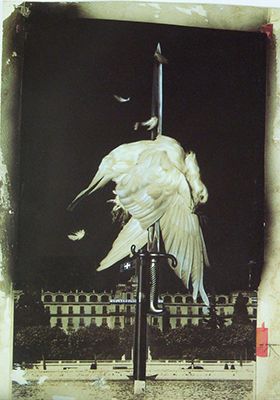
The Meaning of Geneva, Peace Cannot Live Where Greed Capital Exists!
This photomontage focuses on a white dove, a symbol of peace, impaled by a bayonet, symbol of modern warfare. The simplicity of this composition recalls the qualities of the "object poster" and draws attention to how Heartfield deployed advertising techniques to create an affective critical, yet emotional reading of this historical event. Published on the cover of the November 27th issue of the AIZ, Heartfield reacts to the Geneva disarmament conference that took place on November 9, 1932, as well as comments on the police's violent reaction against protesters who demonstrated against fascism in front of the palace of the United Nations. The conference's outcome revealed itself three days later in Geneva, when England, France, and Italy granted Germany equal military rights. Heartfield's montage simultaneously grasps the implications of the present action and anticipates the future in the form of a Socialist Surrealism grounded in the imagery of the 1930s.
Heartfield was inspired by two contemporary images that were produced on the occasion of the Geneva conference: the Swiss stamp issued on the occasion of the disarmament conference, showing a dove freely hovering over a broken sword, and the caricature of a dove impaled by a sword, published in the Moscow newspaper Pravda. In this photomontage, Heartfield subtracts the sword and added the bayonet; he disassembles conventional representations of the Geneva conference and reassembles the pieces to make visible the underlying meaning of this conference that granted Germany permission to rearm.
Heartfield's original AIZ photomontage was reworked and used as the front cover of the December 1939 issue of the progressive journal Direction, a legendary progressive journal that chronicled the troubles of the thirties through fiction, photography, music, art, drama, and humor. William Gropper edited the magazine out of Darien, Connecticut.
Offset - Getty Research Institute, Los Angeles
Biography of John Heartfield
Childhood
John Heartfield was born Helmut Franz Josef Herzfeld in Berlin on June 19, 1891. His father Franz Herzfeld was a Jewish socialist writer, dramaturg, and poet; and his mother was a textile worker and political activist. Helmut may have grown up poor, because his father chose to become a radical, almost anarchist writer under the pen name Franz Held. Yet, his father came from an established middle-class family. His grandfather Jonas had a successful cotton textile business in Neuss bei Düsseldorf and his wealth was divided among four sons. How this inheritance benefitted Helmut's family is uncertain. Grandfather and grandson Herzfeld shared similar leftist political views. Karl Marx was a frequent guest at grandfather Jonas' house.
Four years after Helmut's birth, his brother Wieland and sister Hertha were born. The family left Berlin and moved to Switzerland, to the northern edge of the Vierwaldstättersees to a town called Weggis. Wieland Herzfelde, Helmut's younger brother, later explained that the reason for the family's move to Switzerland was due to their father's conviction for blasphemy. To avoid jail, Franz fled with his family.
Shortly after settling in Weggis, a fourth child, Charlotte, was born. Both parents became ill; Alice suffered from depression. Fearing that they would lose custody of their youngest child, because the authorities considered them incapable of caring for an additional child; Franz and Alice Herzfeld once again fled. They settled in Gaisberg above the Aigen, a city district southwest of Salzburg in Austria, where they lived in an abandoned mountain hut. One summer night in 1899, both parents mysteriously disappeared. The oldest son Helmut, then eight years old, had to care for his three younger siblings. The authorities were aware of the bad health of both parents; the mayor from Aigen, Ignaz Varnschein and his wife Klara, discovering the abandoned children four days later, took them into their foster care.
The children's uncle Josef, the older brother of their father Franz, a successful lawyer in Berlin and administrator of his grandfather's estate, provided financial support to the itinerant family in the form of a guardian trust. The actual care for the children, however, was left to the Varnscheins. Helmut grew up as an anxious, troubled, and quick-tempered child, which resulted from the mistreatment he received as a Protestant boy raised in a Catholic household in imperial Austrian society. When the Varnscheins moved to Salzburg, Helmut was placed in the home of the Bischof family. Around this time, Helmut ran away from home, then from school, and even organized a school strike, according to Wieland Herzfelde, Heartfield's main biographer. After the school revolt, Helmut spent time in a juvenile detention home run by nuns. However on hearing about his mistreatment at the institution, the Varnscheins took the boy back.
Early Training and Education
In 1901, Helmut began going to school. Yet, four years later, he was thrown out of it. At the age of 14, he moved to Wiesbaden where he was able to live and enter into an apprenticeship with Helena and Heinrich Heuss, who was a book dealer and owner of a small publishing company. In Wiesbaden, Helmut started his artistic training at the state-run University of the Arts (Kunsthochschule). Because he showed talent, he was inscribed into the Royal Academy of Arts and Crafts (Koniglichen Kunstgewerbeschule) in Munich, where he studied painting and design for two years with Albert Weisgerber and Ludwig Hohlwein. He then worked as a graphic designer for advertising at the Bauer Brothers' Printing Company (Druckerei der Gebruder Bauer) in Mannheim. He then returns to Berlin, where his uncle had secured him a place at the School of Arts and Crafts (Kunstgewerbeschule) in Charlottenburg. Here he studied with the well-known artist and graphic designer Ernst Neumann, who made a lasting impact on Heartfield's way of working.
As of 1914, Helmut and his brother Wieland became part of the bohemian circles in Berlin. It is around this time that Helmut carefully crafted an artistic persona with the help of his younger brother that proffered a fragile young man ruled not by reason but by deeply authentic and uncontrollable emotions free of civilizing constraints - reminiscent of his father's own romantic sensibilities. This new persona fit into their new bohemian lifestyle and was inspired by the writer and poet Else Lasker Schuler, who the two brothers admired and befriended. She even took part in cultivating the story of Helmut's madness, which was very much based on his impulsive character, now interpreted as a "creative fury."
Part of Helmut's artistic identity was the story of his wild attack on his military officer to avoid military service. Helmut actually suffered from Jackson Epilepsy and as a result, he was exempted from serving. In 1914, neither Helmut nor his brother Wieland mentioned this illness, instead they had a ready anecdote that explained that Helmut's aggressive temper got him expelled from the military.
Helmut Herzfeld further underscored his antiwar gesture by anglicizing his name to John Heartfield, just as Germany declared war on Britain in 1916. This was a cheeky rejection of Germany's anglophobia and an assertion in no uncertain terms of his internationalist and anti-militarist convictions.
Together with their close friend and fellow satirical artist George Grosz, Heartfield, and his brother Wieland Herzfelde (who added an "e" to the end of his last name as a poetic flourish) wasted no time in expressing their new radical-left outlook in an immediate and intelligible form in the newly founded journal the New Youth (Die Neue Jugend). At this time, Heartfield became immersed in the print medium and its public culture. Imitating Franz Pfemfert's journal The Action (Die Aktion), he reprinted excerpted material from other, recently published sources in the New Youth. These three collaborators continued to develop other satirical magazines, after New Youth was censored, such as Bankruptcy (Die Pleite).
Herzfelde and Grosz were called to a second tour of duty after long respites in Berlin: Herzfelde left in November 1916 and Grosz left sometime after January 4, 1917. This left Heartfield in charge of New Youth. Remarkably he continued printing the periodical and published a double February/March issue shortly before the ban of it. Even two weekly editions subsequently hit kiosks without a permit. This was possible because of the help of Franz Jung, who was adept at getting around the censors.
In 1918, the German November revolution aimed to harness the political vacuum left in the wake of WWI and the severe disillusionment with war. But it failed. The sobering experience of war and revolution, military and economic devastation, as well as social and cultural crisis found expression in the literary and artistic avant-garde. This experience politicized Heartfield and his brother, who in December 1918 joined the Spartacus League (a formative German Communist Party). In 1919, Heartfield and his brother Wieland became founding members of the Berlin Dadaists, and collaborated extensively with George Grosz, Raoul Hausmann, and Hannah Höch.
Wieland had by now become editor and publisher of the Malik Publishing Company (Malik Verlag) and Heartfield was its informal artistic director. The Malik Verlag acted as the quasi-headquarters of the Berlin Dadaists at the time, publishing their satirical newspapers, books and journals, such as the single issue of the humor magazine Everyman his own Football (Jedermann sein eigner Fussball) with a Heartfield montage on the cover, and the satirical magazine Dada, which had a short run. Together with their fellow Dadaists, Heartfield and his brother focused their actions upon the deceitful and false application of language (word and images) in advertising and propaganda, despite government censorship. It is around this time that Heartfield took on the persona of Monteur (engineer), donning overalls to avoid looking like an artist or an adman.
Because Heartfield had a growing family to care for, he needed a steady income. He had married Helene Balzar and they had two children, a son Tom and a daughter Eva. Heartfield therefore began to work as a stage designer for Max Reinhardt's theater, where he met the young writer and dramaturg Bertolt Brecht. He went on to collaborate in Erwin Piscator's proletarian theater, parallel to working for his brother's Malik Verlag.
On the occasion of the tenth anniversary of the First World War, Heartfield expressed his strong sentiments against war in a photomontage After Ten Years" which visualizes for the first time his views against war. This poster-size image hung in the window of his brother's Malik Verlag, arousing much controversy. It signals Heartfield's transition from Dada to full fledge political photomonteur.
Mature Period
By 1924, Heartfield had made his mark on the use of photography in book design for his brother's Malik Verlag. He cleverly devised a unique and highly successful formula for book jacket designs that appealed to a broad audience, encouraged booksellers to display the book prominently, and ultimately to sell the books. It became widely emulated at the time. Some of his more well-known dust jacket designs were for the books authored by the American leftist writer Upton Sinclair, "The Swamp," "100%," and "This is how you make dollars."
At times, the Malik Verlag assisted Willi Münzenberg, head of the International Worker's Aid (Internationale Arbeiterhilfe, IAH), a leftist, supraparty organization. It published a series of Münzenberg's writings and a call for a fundraising effort among artists in its newspaper The Opposer (Der Gegner). This close collaboration at the Malik Verlag made it possible for Heartfield to meet Münzenberg, who sought out artists like him who could create effective visual propaganda for the IAH.
Heartfield's goal to create a community of revolutionary-minded citizens who would actively contribute to radical social change, complimented Münzenberg's project to create a collective worker illustrated magazine. This was evident in Heartfield's front cover design for the journal The New Russia's special issue dedicated to "10 years of Soviet Union 1917-1927" (November 1927), published by Münzenberg's New German Publishing Company (Neuer Deutsche Verlag).
At the end of the twenties, when Heartfield had achieved much success, ranging from popular appeal to mainstream approval: He was hailed in the leading graphic arts journal Commercial Graphics (Gebrauchsgrafik), designed a myriad of SPD (German Social Democratic Party) and KPD (German Communist Party) publications, especially the KPD's organ the Red Flag (Die Rote Fahne); well represented in the exhibition "Photomontage" in Berlin in 1929, and had his own room in the well-known 1931 Film und Foto (FIFO) exhibition in Stuttgart. Heartfield then began to work exclusively for the Workers' Illustrated Magazine (Arbeiter-Illustrierte Zeitung, AIZ).
Working for the AIZ brought about a further change in Heartfield's montage-practice, because it was a modern picture magazine that required him to adapt to the conditions of commercial photojournalism and his work being printed in rotogravure. The AIZ showcased Münzenberg's new collective photojournalism that focused on the worker, as both subject and audience.
In the midst of this creative activity, Heartfield married Barbara Friedmann, who would accompany him through the next episode of his life until he fled Berlin in 1933.
Heartfield undertook a business trip for the AIZ to the Soviet Union from April 1931 to January 1932. He traveled to Baku, Batumi, and Odesa on behalf of the Soviet newspaper USSR in Construction. During these trips, he held photomontage workshops for Red Army officers and for photomontage artists and printers at the Graphic Institute, gave numerous lectures, and designed a special issue for which he created the Lenin montage. A Heartfield exhibition was mounted at the All-Russian Cooperative of Artists in the center of Moscow, displaying 300 works. Heartfield met leading avant-garde artists, such as Gustav Klucis, El Lissitzky, and Alexander Rodchenko. He formed a close friendship with the prominent writer Sergei Trejakov. Yet, Heartfield found his work heralded and criticized, because his photomontages were both effective propaganda and formalist arrangement.
Late Period
Beginning in the fall of 1932, Heartfield openly differed in opinion from the official German Communist Party line and like the AIZ expressed an antifascist position, which was initially evident in the montage for the cover of the AIZ 24 July 1932 issue and became readily apparent in his AIZ photomontages, which focused on criticizing Hitler.
On the night of April 14, 1933, Heartfield dared to return to his apartment to gather the artworks he wanted to take with him into exile, even though he knew the SS (a paramilitary Nazi organization) was after him. Having avoided arrest, the actor Heinz Greif helped him flee over the Sudeten Mountains to Czechoslovakia.
Heartfield's imagery of a menacing fascism proved influential in Europe in the early thirties, creating a persuasive web of political unity just as Heartfield found himself embroiled in controversy in Prague. Heartfield contributed 36 AIZ photomontages to the Third International Caricature Exhibition at the Mánes Art Association in Prague in April 1934. The German authorities found five anti-Nazi montages offensive and demanded they be removed from the front display windows to the back of the exhibition. Then, they intervened a second time, requesting that the five montages be removed from the exhibition all together. The photomontage "On the occasion of the intervention of the Third Reich" (AIZ, May 3, 1934) comments on the German authorities intervention against the display of Heartfield montages at this exhibition. This episode of an international diplomatic scandal provoked by Heartfield's anti-fascist montages was widely publicized. To counteract the imposed censorship over the Mánes exhibition in Prague, Paul Signac, Président des Société des Artistes, organized a Heartfield exhibition in Paris in Spring 1935, which opened to much success. During his stay in Paris, Heartfield met Tristan Tzara, Louis Aragon (who wrote a short essay "John Heartfield and Revolutionary Beauty"), Eduard Fuchs, and even Walter Benjamin.
In 1938 Heartfield fled to London, where he lived for twelve years. He joined the Free German Culture Association and his work was shown in two key exhibitions in 1939. After World War II commenced, Heartfield was interned with other German emigrants in an internment camp over six weeks. It was during this very difficult time that he met his third wife Gertrude (Tutti) Fietz, who became the guardian of his estate. Eventually he worked as a graphic designer in 1943 at a new publishing company, Lindsay Drummond and then, at Penguin Books.
Heartfield reconnected with his brother, friends, and comrades in Leipzig and Berlin, when he arrived on August 31, 1950 in East Germany. During the first years there, he was not permitted to work, along with other communist artists. As the art historian Peter Selz pointed out, "While he was celebrated as a cultural leader, his chief idiom, photomontage, was still suspect during the 1950s among the more orthodox advocates of socialist realism." Bertolt Brecht, one of the few who succeeded in starting a project, namely his own theater The Berliner Ensemble, offered Heartfield a job designing his theater posters. However, Heartfield never returned to producing his radical photomontages.
After ten months in Germany, Heartfield suffered a heart attack on May 2, 1951 and a second heart attack a year later. He eventually received an honorary pension from the East German government, starting in 1954. However, Heartfield continued to work tirelessly for the theater, especially Brecht's Berliner Ensemble and for the Deutsche Theater in Berlin. Heartfield passed away at the age of 76 in 1968.
The Legacy of John Heartfield
The admiration for Heartfield's work was evident already during his lifetime, especially in the graphic designs by Alexander Liberman (alias Alexandre), who adopted Heartfield's montage-technique for the front covers of the French illustrated journal Vu, the satires of Marianus in the pages of the communist journal Mariane, the photomontages of Josep Renau, Aleksandr Zhitomirsky, and many instances where his AIZ montages were reprinted in Spanish and French communist daily magazines, such L'Humanité and the anarcho-syndicalist journal Orto.
Artists from across the Eastern bloc, Soviet Russia and the United States found inspiration in Heartfield's photomontages in the late 1960s and 1970s. For artists like Klaus Staeck, László Lakner, and Martha Rosler, among others, his work helped them confront a worn out leftist ideology with a new form of leftist critique, using historical referents and context driven meaning, to reclaim civil society, their artistic independence, and to articulate alternative social, political and cultural viewpoints during the Cold War, in both the East and the West.
Influences and Connections

-
![Honoré Daumier]() Honoré Daumier
Honoré Daumier - Ernst Neumann
- Franz Pfemfert
-
![George Grosz]() George Grosz
George Grosz ![Bertolt Brecht]() Bertolt Brecht
Bertolt Brecht- Franz Jung
![Alexander Liberman]() Alexander Liberman
Alexander Liberman- Marianus
- Josep Renau
- Klaus Staeck
- László Lakner
- Aleksandr Zhitomirsky
- Gustav Klucis
- Sergei Trejakov
Useful Resources on John Heartfield
- John Heartfield and the Agitated Image: Photography, Persuasion, and the Rise of Avant-Garde Photomontage (2012)Our PickAn investigative look at the art making practices of the artist
- John Heartfield: Art and Mass Media (1986)Images and Essays analyzing the connection between John Heartfield's work and mass media
- John Heartfield: Laughter is a Devastating Weapon (2015)Our PickIndex of 150 reproductions of the artist's works
- Revolutionary Beauty: The Radical Photomontages of John Heartfield (2014)Compilation of works by the artist
- John Heartfield (1992)Comprehensive collection of the artist's works over the span of his career
- John Heartfield, AIZ/VI 1930-1938 (1992)
